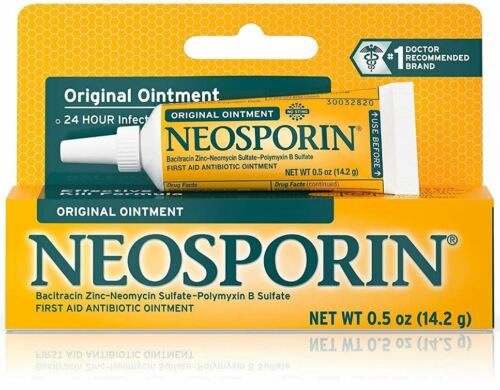As a cat owner, you always want the best care for your furry friend, especially when they get a cut or scrape. You may wonder, is Neosporin ok for cats? While Neosporin is a trusted antibacterial ointment for humans, using it on cats is a different story. Many pet owners assume that applying Neosporin is harmless, but it can pose serious risks. Understanding the potential dangers and safe alternatives can help keep your cat safe and healthy.
What is Neosporin?
Neosporin is an over-the-counter antibiotic ointment used to prevent infections in minor cuts, burns, and scrapes. It contains three main ingredients:
- Bacitracin – an antibiotic that helps stop bacterial growth.
- Neomycin – effective in treating bacterial infections but known for causing allergic reactions in some animals.
- Polymyxin B – another antibiotic that fights bacteria but has been linked to toxicity in cats.
Though these ingredients work well for humans, they can be problematic for felines.
Is Neosporin Safe for Cats?
Many veterinarians advise against using Neosporin on cats. While some claim that a small amount may not cause harm, the risks often outweigh the benefits.
- Risk of Ingestion – Cats groom themselves constantly. If you apply Neosporin to a wound, your cat will likely lick it off. Ingesting Neosporin can cause serious health issues.
- Allergic Reactions – Some cats are allergic to neomycin, leading to swelling, itching, and redness. Severe reactions could result in anaphylactic shock.
- Nephrotoxicity – Polymyxin B, an ingredient in Neosporin, has been linked to kidney damage and other toxic effects in cats.
Considering these risks, it’s best to avoid using Neosporin without veterinary guidance.
Dangers of Neosporin for Cats
Applying Neosporin on your cat can lead to unintended consequences. The most common risks include:
- Digestive Issues – If ingested, Neosporin can cause vomiting, diarrhea, and nausea.
- Severe Toxicity – Polymyxin B, one of the active ingredients, has been known to cause life-threatening reactions, including difficulty breathing, weakness, and even death in rare cases.
- Skin Irritation – Some cats may experience increased redness, burning, or inflammation at the application site.
- Eye Damage – Never apply Neosporin near your cat’s eyes, as it can cause severe irritation or damage to the cornea.
Because of these dangers, it’s always best to consult a veterinarian before applying any antibiotic ointment to your cat.
Safe Alternatives to Neosporin for Cats
Instead of using Neosporin, opt for safer alternatives that are feline-friendly. Here are some veterinarian-approved options:
- Veterinary Antibiotic Ointments – Specially formulated antibiotic creams designed for pets are available at vet clinics and pet stores.
- Chlorhexidine Solution – A mild antiseptic that can be used to clean minor wounds without causing harm.
- Silver Sulfadiazine Cream – Often prescribed for burns or bacterial infections, this cream is safe for cats when used under veterinary supervision.
- Aloe Vera Gel – A natural alternative that can soothe minor burns and scratches, but ensure it is free from added chemicals.
- Diluted Iodine (Betadine) – A safe antiseptic that helps disinfect wounds without the risks associated with Neosporin.
Using these alternatives minimizes the risks while still promoting healing in minor injuries.
How to Treat a Cat’s Wound Safely
If your cat gets a minor wound, follow these steps for safe treatment:
- Assess the Wound – Check if the wound is deep or bleeding excessively. If so, visit a veterinarian immediately.
- Clean the Area – Use warm water and mild soap to clean the wound. Avoid using hydrogen peroxide, as it can damage skin cells.
- Apply a Safe Antiseptic – Use diluted iodine or chlorhexidine solution to disinfect the wound.
- Monitor for Signs of Infection – Look for swelling, pus, or worsening redness, which may indicate an infection.
- Prevent Licking – If necessary, use an Elizabethan collar (E-collar) to prevent your cat from licking the wound.
- Consult a Veterinarian – If the wound doesn’t heal or shows signs of infection, seek professional advice.
Taking the right precautions ensures your cat recovers quickly without unnecessary complications.
Conclusion
So, is Neosporin ok for cats? The answer is no—it is generally not recommended due to potential risks. While Neosporin works well for humans, its ingredients can cause toxicity, allergic reactions, and digestive issues in cats. Instead, opt for safer alternatives such as veterinary-approved antibiotic ointments or mild antiseptics. If your cat has a wound, proper cleaning and veterinary guidance will ensure the best care. Always prioritize your cat’s safety by using treatments specifically formulated for felines.
Frequently Asked Questions
Can I use Neosporin on my cat’s wound?
Neosporin is not recommended for cats due to risks of toxicity, allergic reactions, and ingestion. Instead, use a pet-safe alternative.
What happens if my cat licks Neosporin?
Ingesting Neosporin can lead to digestive upset, vomiting, diarrhea, and in severe cases, toxicity from polymyxin B.
What is the best antibiotic ointment for cats?
Veterinarian-recommended ointments such as silver sulfadiazine cream or pet-specific antibiotic creams are the safest options.
How can I prevent my cat from licking a wound?
Use an Elizabethan collar (E-collar) or bandage the area carefully to prevent your cat from licking the wound.
Are there any natural remedies for treating my cat’s wounds?
Aloe vera gel and diluted iodine can be used safely, but always consult your veterinarian before using any home remedies.
For more expert advice on cat health and care, visit MeowMasters.com.

1 thought on “Is Neosporin Ok for Cats? Everything You Need to Know”